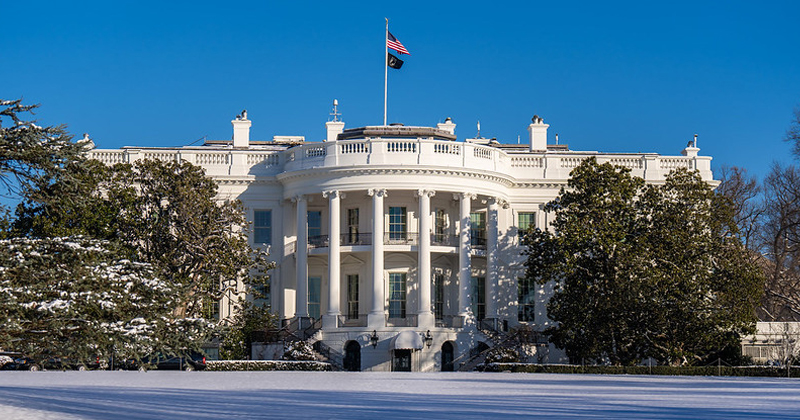


Presidential inaugurations
Official White House Photo by Adam Schultz January 17, 2025
UD faculty experts examine the history of Inauguration Day
Before there was a United States of America, officials in the American colonies swore an oath of allegiance to the King of England. Leading up to George Washington’s first inauguration in 1789, Congress debated if the new nation should adopt the tradition of swearing allegiance to the country, with some arguing that it was an outdated symbol of obedience.
Despite the opposition, Washington recited the 35-word oath of office, with every American president following suit.
While many aspects of the day’s events have evolved in 250 years, that first inauguration set several traditions that are still followed today. The University of Delaware has even played its part in welcoming U.S. presidents to office, including the inauguration of one of its own.
Inauguration Day, held Jan. 20, has great significance for the United States.
“The inaugural event has historically signified the peaceful transition of power and to allow the new president to set forth a vision for the country through the inaugural address,” said David Redlawsk, James R. Soles Professor of Political Science and chair of the Department of Political Science and International Relations at the University of Delaware. “The pageantry can be important as a unifying practice for a country following hard-fought elections.”
Inauguration Day offers a glimpse into American history and the democratic process. Below are a few facts you may not have known about U.S. presidents assuming office.
The oath of office
During the inauguration, the president-elect recites the following oath: I do solemnly swear (or affirm) that I will faithfully execute the Office of President of the United States, and will to the best of my ability, preserve, protect and defend the Constitution of the United States.
“The emphasis here is that the office holder is sworn to uphold the form and procedures of the government,” said Dael Norwood, associate professor in the Department of History. “The founding generation were deeply wary of any kind of government rooted in blood or soil, and instead built a nation founded on a set of ideas.”
From March to January
Inauguration Day was initially held on March 4, until the 20th Amendment to the Constitution was ratified.
“The amendment passed Congress at the kickoff of the 1932 campaign, when it was clear that the incoming president would need to act quickly to address the already very, very bad conditions of the Great Depression,” Norwood said.
The amendment was ratified between Franklin D. Roosevelt’s first and second terms, moving Inauguration Day to Jan. 20 and shortening the lame duck period between November elections and incoming administrations. Roosevelt’s second term began Jan. 20, 1937.
The inaugural address
Washington gave the shortest inaugural address — just 135 words long — during his second inauguration on March 4, 1793. By contrast, the longest inaugural address logged in at 8,445 words when William Henry Harrison delivered his address on March 4, 1841.
Regardless of length, these speeches have contributed to the American English lexicon, according to John Ernest, Judge Hugh Morris Professor and chair of the Department of English.
“Almost all inauguration speeches call for the nation to ‘start fresh’ or call for a change in direction, but some include memorable lines that have a life that extends long after the speech and long after the president’s term,” he said.
Examples include Abraham Lincoln’s oft-quoted line “with malice toward none, with charity for all” from his second inaugural address on March 4, 1865, and Ronald Reagan’s 1981 proclamation, “We are a nation that has a government — not the other way around.”
John F. Kennedy said his famed line, “And so, my fellow Americans, ask not what your country can do for you — ask what you can do for your country,” during his 1961 inaugural address.
Pomp and parades
Washington is credited with having the first inaugural parade when a group of 500 military men escorted him to Federal Hall in New York; however, the first several inaugurations held in Washington, D.C., were more dressed-down events. By 1837, the inaugural parade was in full force with parade floats accompanying Martin Van Buren’s inauguration.
Lincoln’s second inauguration in 1865 marked the first time Black Americans formally participated in the inaugural parade, and women first participated during the 1917 parade for Woodrow Wilson.
Warren G. Harding was the first president to ride in an automobile in 1921, and in 1977, Jimmy Carter was the first president to walk the modern parade route from the Capitol to the White House.
Modern inaugural parades include military units and civilian groups, often representing the incumbent president and vice president’s home towns or alma maters.
The full UD Marching Band was selected to appear in the 2009 Presidential Inaugural Parade for President Barack Obama and Vice President Joe Biden, a UD alumnus.
In 2021, the UD Drumline escorted President Biden on his way to the White House. Most Inauguration Day events were held virtually that year, and the Drumline Battery was one of only two civilian groups to participate in live inauguration events, an incredible honor for UD.

Contact Us
Have a UDaily story idea?
Contact us at ocm@udel.edu
Members of the press
Contact us at mediarelations@udel.edu or visit the Media Relations website

